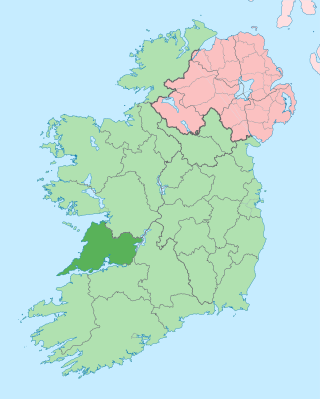
County Clare is a county in the province of Munster in the Southern part of the republic of Ireland, bordered on the west by the Atlantic Ocean. Clare County Council is the local authority. The county had a population of 127,938 at the 2022 census. The county seat and largest settlement is Ennis.

Ballyvaughan or Ballyvaghan is a small harbour village in County Clare, Ireland. It is located on the N67 road on the south shores of Galway Bay, in the northwest corner of The Burren. This position on the coast road and the close proximity to many of the area's sights has turned the village into a local center of tourism activity. At the time of the 2011 census Ballyvaughan had a population of 258. The area was officially classified as part of the West Clare Gaeltacht, an Irish-speaking community, until 1956.

Ennistymon or Ennistimon is a country market town in County Clare, near the west coast of Ireland. The River Inagh, with its small rapids known as the Cascades, runs through the town, behind the main street. A bridge across the river leads to nearby Lahinch. The town is at the junction of the N67 and N85 roads.

Lahinch or Lehinch is a small town on Liscannor Bay, on the northwest coast of County Clare, Ireland. It lies on the N67 national secondary road, between Milltown Malbay and Ennistymon, roughly 75 kilometres (47 mi) by road southwest of Galway and 68 kilometres (42 mi) northwest of Limerick. The town is a seaside resort and is home to the Lahinch Golf Club. It has become a popular surfing location.

Spanish Point is a village in the parish of Milltown Malbay in County Clare on the west coast of Ireland. It has many holiday homes, and in winter a significantly smaller population. The Beach, over a kilometre long, has Blue Flag Status and is suitable for swimming and surfing. It is also one of the better known surf breaks in County Clare. The name refers to the wrecking of some ships of the Spanish Armada off the coast.

Scarriff or Scariff is a large village in east County Clare, Ireland, situated in the midwest of Ireland. The town is on the West end of Lough Derg and is best known for its harbour. The Scarriff Market House is easily recognisable, and it is therefore often used to represent the town.
Johnny Doran was an Irish uilleann piper.

Milltown Malbay, also Miltown Malbay, is a town in the west of County Clare, Ireland, near Spanish Point. The population was 829 at the 2016 census.
Mullagh is a village in County Clare, Ireland. It lies not far from the Atlantic coast, some 5 km southeast of Quilty and 6.5 km south-southeast of Spanish Point. Nearby towns include Milltown Malbay and Kilrush.

Quilty, historically Killty, is a small fishing village between Milltown Malbay and Doonbeg in County Clare, Ireland. Lobster, salmon, bass, herring and mackerel are landed at Quilty, formerly known for its curing industry. The area was officially classified as part of the west Clare Gaeltacht, an Irish-speaking community, until 1956.

Glin is a village in the northwest of County Limerick, Ireland. It is on the south shore of the River Shannon's estuary, on the N69 road between Foynes and Tarbert. The population of the village at the 2022 census was 644.
Nonie Lynch was an Irish traditional singer from Milltown Malbay, County Clare.

The Burren and Cliffs of Moher Geopark is an internationally designated area of geological interest in The Burren region of County Clare, Ireland. It is the third Geopark to be designated in Ireland, and is recognised at both European and global levels.
The Laichtín Naofa Céilí Band is a former céilí band based in Milltown Malbay, County Clare, Ireland.

Garret(t) Barry was a blind Irish uilleann piper from Inagh, County Clare, among the most famous players of the 19th century.

Kilmurry Ibrickane (Irish: Cill Mhuire Uí Bhreacáin), also known as Mullagh (Kilmurry Ibrickane), is a parish of the Roman Catholic Diocese of Killaloe that is located in west County Clare, Ireland. A civil parish of the same name also exists which is part of the historic barony of Ibrickane. The parish derives its name from the tiny settlement of Kilmurry in Ibrickane, the location of the church before Cromwellian times.

Ennistymon House was a former country house in the village of Ennistymon, County Clare in Ireland. Built on the elevated site of a medieval castle it has now been incorporated into the Falls Hotel.
Kilmoon is a civil parish of County Clare, Ireland, 7 miles (11 km) north of Ennistymon. The parish contains the town of Lisdoonvarna.

Doonbeg (Killard) (Irish: Cill Ard) is a civil parish on the Atlantic coast of County Clare in Ireland. It is also an ecclesiastical parish in the Roman Catholic Diocese of Killaloe. The largest population centre in the parish is the village of Doonbeg.
Kilfarboy is a civil parish in County Clare in Ireland. There is also a Catholic parish with the same name. The largest population centre in the parish is Milltown Malbay.

















